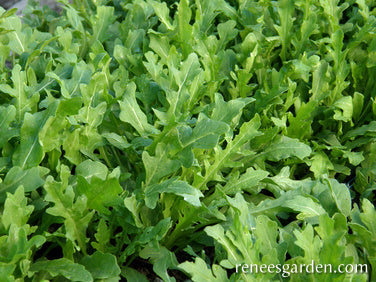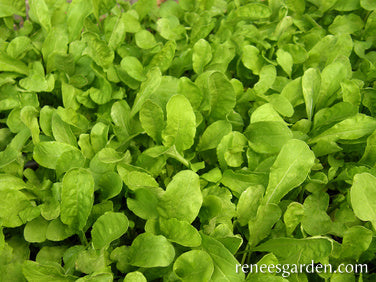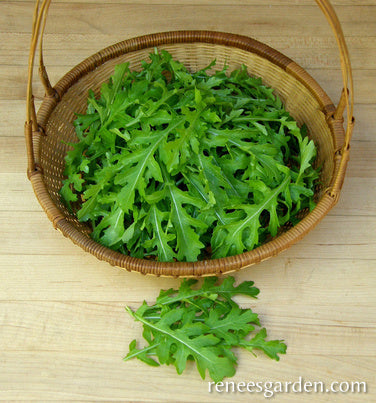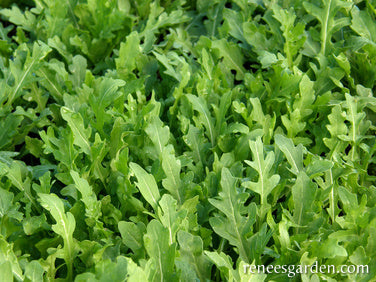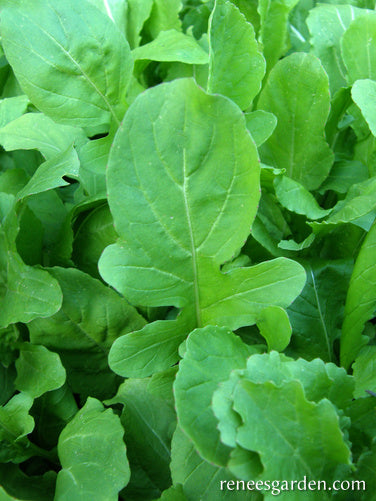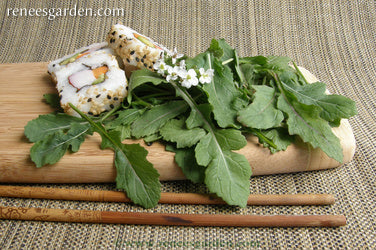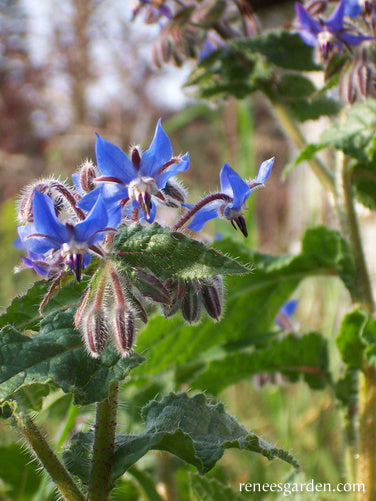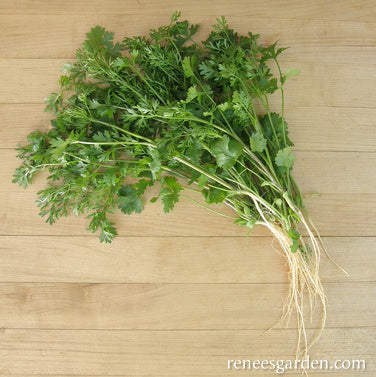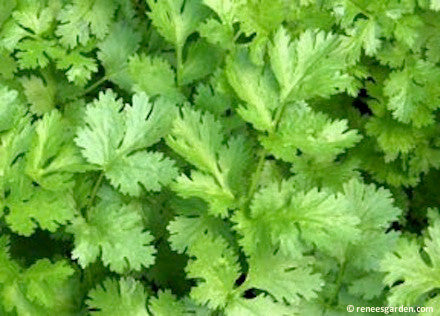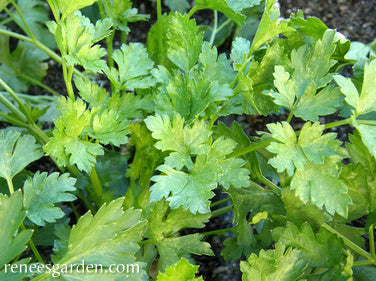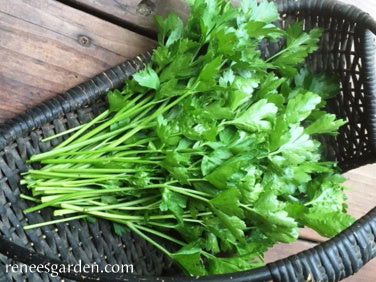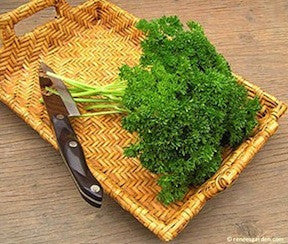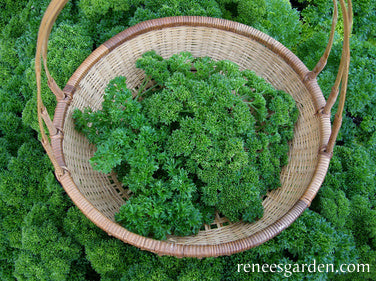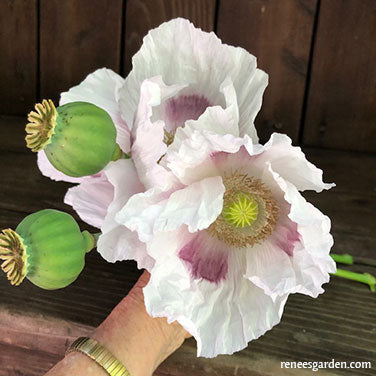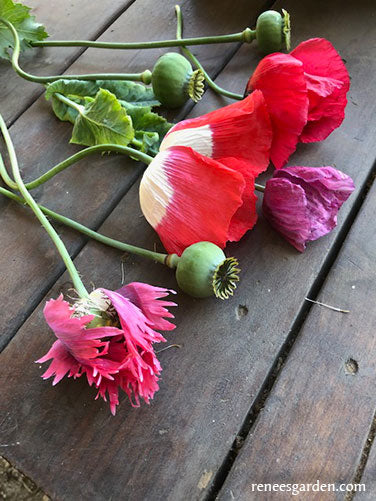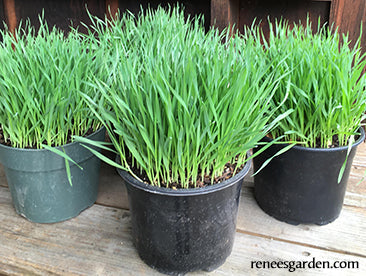Cool Season Herbs
Cool Season Herbs
-
Kitchen Herbs Heirloom Rustic Arugula
HALF-HARDY PERENNIAL
Spring/Summer/Fall harvest
Can handle light frost
EASIEST TO START OUTDOORS
Plant seeds in early spring or in late summer for a fall crop. Sow seed as thinly as possible, cover 1/4 inch deep and firm soil gently over seeds. Keep seedbed evenly moist until seedlings emerge in 7 to 14 days.
THIN OR TRANSPLANT
Thin seedlings 5 to 6 inches apart when plants are large enough to handle.
GROWING NOTES
Long lasting rustic arugula stays leafy so you can harvest all season long from the same plants. Harvest individual leaves at 4 to 5 inches long, or cut bunches of young tender leaves as needed. Keep little yellow blossoms pruned back for best leaf production or use for tangy edible flowers. Rustic Arugula will winter over in mild climate areas, but make a fresh sowing each spring for best quality.Regular price $2.99Sale price $2.99Unit price / per -
Kitchen Herbs Italian Arugula
ANNUAL
Spring/summer/fall harvest
Frost hardyEASIEST TO START OUTDOORS
In early spring, sow seeds directly into well-worked garden soil in full sun or in a sunny spot with afternoon shade. Broadcast seed 2 inches apart, cover 1/4 inch deep and firm soil over seeds. Keep seed bed evenly moist until seedlings emerge. Make new sowings every 2 weeks until early summer for a constant supply of fresh non-bitter leaves. Begin harvesting young leaves in 3 to 4 weeks.
In hot summer areas, wait to sow again in late summer for fall use, as summer heat makes leaves very pungent.
THIN OR TRANSPLANT
Arugula grows so quickly we recommend sowing in place rather than transplanting. Thin seedlings 2 to 3 inches apart when plants are large enough to handle.
GROWING NOTES
Begin harvesting by thinning little seedlings to use in salads when they are several inches tall. Then, either pick individual leaves when 3-4 inches long, or snip leaves about 1 inch above the crown and let plants regrow for more harvests.Regular price $2.99Sale price $2.99Unit price / per -
Salad Herbs Runway Arugula
ANNUAL
Spring/summer/fall harvest
Frost hardyEASIEST TO START OUTDOORS
In early spring, sow arugula seeds directly into well-worked garden soil, cover ¼ inch deep and firm soil over seeds. Keep seed bed evenly moist until seedlings emerge. Make new sowings every 2 weeks until early summer to have a constant supply of fresh leaves. Begin harvesting young leaves in 3 to 4 weeks.
In hot summer areas, wait to sow again in late summer for fall use, as extreme heat makes leaves very pungent.
THIN OR TRANSPLANT
Arugula grows so quickly we recommend sowing in place rather than transplanting. Thin seedlings 2 to 3 inches apart when plants are large enough to handle.
GROWING NOTES
Begin harvesting by thinning little seedlings to use in salads when they are several inches tall. Then, either pick individual leaves when 3-4 inches long, or snip leaves about 1 inch above the crown and let plants regrow for more harvests.
Regular price $2.99Sale price $2.99Unit price / per -
Heirloom Arugula Rustic Style
EASIEST TO START OUTDOORS
Plant seeds in early spring or in late summer for a fall crop. Sow seed as thinly as possible, cover 1/4 inch deep and firm soil gently over seeds. Keep seed-bed evenly moist until seedlings emerge in 1 to 2 weeks.
THIN OR TRANSPLANT
Thin seedlings 5 to 6 inches apart when plants are large enough to handle.
GROWING NOTES
Long lasting rustic arugula stays leafy so you can harvest all season long from the same plants. Harvest individual leaves at 4 to 5 inches long, or cut bunches of young tender leaves as needed. Keep the little yellow blossoms pruned back for best leaf production or use for tangy edible flowers. Rustic will winter over in mild climates but make a fresh sowing each spring for best quality.
Regular price $4.89Sale price $4.89Unit price / per -
Arugula True Italian
EASIEST TO START OUTDOORS
In early spring, sow seeds directly into well-worked garden soil 1 to 2 inches apart in rows 10 inches apart in full sun. Cover 1/4 inch deep and firm soil over seeds. Keep seed bed evenly moist until seedlings emerge in 7 to 14 days. Make new sowings every 2 weeks until early summer for a constant supply of fresh non-bitter leaves. Young leaves are ready to begin harvesting in 3 to 4 weeks. In hot summer areas, wait to sow again in late summer for fall use, as summer heat makes leaves very pungent.THIN OR TRANSPLANT
Arugula grows so quickly we recommend sowing in place rather than transplanting. Thin seedlings 2 to 3 inches apart when plants are large enough to handle.GROWING NOTES
Begin harvesting by thinning little seedlings to use in salads when they are several inches tall, leaving remaining seedlings to mature 2 to 3 inches apart. Either pick individual leaves when they are 3 to 4 inches long, or snip leaves about 1 inch above the crown and let plants regrow for more harvests.Regular price $4.89Sale price $4.89Unit price / per -
Gourmet Herbs Wasabi Arugula
ANNUAL
Spring/summer/fall harvest
Frost hardyEASIEST TO START OUTDOORS
Plant in spring (or late summer for a fall crop) directly into the garden in well-worked soil in full sun, or a spot that receives partial afternoon shade. Sow 1 inch apart and barely cover.
Keep the seed bed evenly moist until seedlings emerge in 10 to 12 days. Begin harvesting individual young leaves in 4 to 5 weeks. In hot summer areas, wait to sow again in late summer for fall use, as extreme heat makes leaves extra pungent.
GROWING NOTES
Harvest early by thinning seedlings to use in salads when they are several inches tall, leaving remaining seedlings to grow to maturity 4 to 5 inches apart. Pick individual leaves when they are 3 to 4 inches long, or snip each whole leafy rosette about 1 inch above the crown and let plants regrow for extended harvests. This long-lasting arugula stays leafy so you can use it all season. Pick the little edible flower stalks of dainty white blossoms off the plants to keep seed heads from forming as this diminishes leaf quality.Regular price $3.69Sale price $3.69Unit price / per -
Kitchen Herbs Blue Borage
HARDY ANNUAL
Spring/summer/fall harvest
Can handle light frostEASIEST TO START OUTDOORS
Sow seeds in spring once weather has settled, 1/2 inch deep and 6 inches apart, in full sun. Keep seedbed evenly moist until germination occurs in 10 to 14 days. When the seedlings are well established, thin the plants to stand about 12 to 18 inches apart to give bushy plants room to mature. Borage will self-sow freely in the garden and can grow in poor soils. Seedlings do not transplant well because plants have a long, fragile tap root.
GROWING NOTES
Borage flowers have a delicate cucumber-like flavor and are pretty, edible garnishes for both green and fruit salads and cool summer drinks. Freeze the sky-blue flowers inside ice cubes to accent herbal iced teas and festive punch, or candy them for decorations. Children love the star-shaped flowers on birthday cakes or just picked fresh and eaten off the plant.
In traditional herbal lore, borage was thought to lift the spirits and inspire courage. Enjoy these cheering plants all summer long.
Regular price $2.99Sale price $2.99Unit price / per -
Vietnamese Heirloom Bac Lieu Cilantro
ANNUAL
Spring/summer/fall harvest
Can handle light frostsEASIEST TO START OUTDOORS
Vietnamese Cilantro doesn’t transplant well; plant seeds directly in the garden. For continuous harvests, start in early spring and make successive sowings every few weeks until summer heat comes on strong. Sow again in cooler fall weather, especially in mild winter areas. Sow seeds in well-drained fertile soil 1 to 2 in. apart in rows 8 in. apart in full sun. Cover 1/4 inch deep and firm soil over seeds. Keep evenly moist as seedlings emerge. Thin seedlings 3 to 4 in. apart before plants get crowded.
GROWING NOTES
Vietnamese cilantro leafs out and flowers quickly as plants mature; lushest, leafy growth is in cooler temperatures of spring and fall. Plants thrive when well watered and thinned early so they have room to grow. If hot weather arrives early, plant in a spot with morning sun and afternoon shade. The lacy flowers of these plants attract beneficial insects and pollinating bees.
HARVEST AND USE
Vietnamese cilantro produces rosettes of leaves low on plants with more finely cut, serrated leaves towards the top. Harvest & use entire plant, including stems, leaves & even young flowers. Traditionally, Vietnamese cilantro is offered on a plate in the center of the table, so diners can help themselves. This delicious edible garnish & flavoring tastes similar to a delicate regular cilantro, but with an additional delicious hint of citrus spice.Regular price $3.69Sale price $3.69Unit price / per -
Heirloom Cilantro
EASIEST TO START OUTDOORS
In early spring, sow Cilantro seed directly into well-drained fertile soil 1 to 2 inches apart in rows 8 inches apart in full sun. Cover 1/2 inch deep and firm soil over seeds. Keep seed bed evenly moist as seedlings emerge over 10 to 20 days. Make new sowings every few weeks until mid summer for continuous harvests of fresh leaves.
THIN OR TRANSPLANT
Cilantro doesn’t transplant well; we advise direct garden sowing. Thin seedlings 3 to 4 inches apart before plants get crowded.
GROWING NOTES
Cilantro plants flower, then set seed quickly as plants mature. Lushest, leafy growth takes place in cooler weather; plant early and throughout cool spring weather and sow again in fall, particularly in mild winter areas. To have a constant supply of fresh leaves, sow every 2 to 3 weeks through early summer. Keep cilantro at its leafy stage longer by keeping plants well watered and being careful to thin seedlings early. Let some of the lacy flowers form to attract beneficial insects and pollinating bees. The fragrant round seeds are called coriander, an aromatic spice used in baking.
Regular price $4.89Sale price $4.89Unit price / per -
Kitchen Herbs Slow-Bolt Cilantro
ANNUAL
Spring/summer/fall harvest
Can handle light frostsEASIEST TO START OUTDOORS
In early spring, sow Cilantro seed directly into well-drained fertile soil 1 to 2 inches apart in rows 8 inches apart in full sun. Cover 1/4 inch deep and firm soil over seeds. Keep seed bed evenly moist as seedlings emerge over 10 to 20 days. Make new sowings every few weeks until mid summer for continuous harvests of fresh leaves.
THIN OR TRANSPLANT
Cilantro doesn’t transplant well; we advise direct garden sowing. Thin seedlings 3 to 4 inches apart before plants get crowded.
GROWING NOTES
Cilantro plants flower, then set seed quickly as plants mature. Lushest, leafy growth takes place in cooler weather; plant early and throughout cool spring weather and sow again in fall, particularly in mild winter areas. To have a constant supply of fresh leaves, sow every 2 to 3 weeks through early summer.
Keep cilantro at its leafy stage longer by keeping plants well watered and being careful to thin seedlings early. Let some of the lacy flowers form to attract beneficial insects and pollinating bees. The fragrant round seeds are called coriander, an aromatic spice used in baking.
Regular price $2.99Sale price $2.99Unit price / per -
Bonus Pack Heirloom Cilantro
ANNUAL
Spring/summer/fall harvest
Can handle light frostsSTART OUTDOORS DIRECTLY INTO THE GARDEN
In early spring, sow cilantro seed directly into well-drained fertile soil 1 to 2 inches apart in wide rows in full sun. Cover 1/2 inch deep and firm soil over seeds. Keep seed bed evenly moist as seedlings emerge over 10 to 20 days. Make new sowings every few weeks until mid summer for continuous harvests of fresh leaves. Plant again in cool fall weather. Thin plants 3 to 4 inches apart before they get crowded so seedlings have room to grow.
GROWING AND HARVEST NOTES
To have a consistent supply of fresh leaves, sow wide rows of cilantro seeds successively every 2 weeks from early spring through early summer. Keep your cilantro patch at its best tasting leafy stage longer by thinning seedlings early and keeping plants well watered. Plant again when weather cools for a quick and tasty fall crop. Cilantro plants will inevitably flower and then set seed quickly when plants get mature. Their lacy white blossoms attract beneficial insects, butterflies and pollinating bees to the garden. The fragrant round seeds that follow the flowers are called coriander, a wonderfully aromatic spice used in baking.Regular price $8.99Sale price $8.99Unit price / per -
Heirloom Parsley Italian Large Leaf
EASIEST TO START OUTDOORS
Start parsley in spring when weather is settled but still cool and/or in late summer in mild winter climates. Plant in full sun or half-day sun if climate is very hot. Sow seeds 1- 2 inches apart into a well-worked fertile seed bed. Cover 1/4 inch deep. Parsley germinates unevenly over several weeks; be patient and keep seed bed evenly moist. Using synthetic row covers to hold moisture during germination is helpful; remove when seedlings are well established.
TO PLANT INDOORS
In early spring, sow seeds 1 inch apart and 1/4 inch deep in a container of seed starting mix. Keep container moist but not soggy until seedlings emerge. Provide a good light source. Feed seedlings frequently until ready to transplant when several inches tall.
THIN OR TRANSPLANT
Space 3 to 4 inches apart when seedlings large enough to handle.
GROWING NOTES
Parsley needs rich moist soil and ample spacing for lush harvests. Thin early and keep well weeded and watered. Begin to harvest sparingly once plants have 8 to 10 leaves. Fertilize frequently with a high nitrogen source.Regular price $4.89Sale price $4.89Unit price / per -
Kitchen Herbs Italian 'Gigante' Parsley
BIENNIAL, GROWN AS ANNUAL
Spring/summer/fall harvest
Frost hardyEASIEST TO START OUTDOORS
Start parsley in spring when weather is settled but still cool and/or in late summer in mild winter climates. Plant in full sun or half-day sun if climate is very hot. Sow seeds 1-2 inches apart into a well-worked fertile seed bed. Cover 1/4 inch deep. Parsley germinates unevenly over several weeks; be patient and keep seed bed evenly moist. Using synthetic row covers to hold moisture during germination is helpful; remove when seedlings are well established.
TO PLANT INDOORS
Sow parsley seeds in early spring in a container of seed starting mix. Cover 1/4 inch deep, and keep container moist but not soggy until seedlings emerge. Provide a good light source. Feed seedlings frequently until ready to transplant when several inches tall.
THIN OR TRANSPLANT
Space 3 to 4 inches apart when seedlings large enough to handle.
GROWING NOTES
Parsley needs rich moist soil and ample spacing for lush harvests. Thin early and keep well weeded and watered. Begin to harvest sparingly once plants have 8 to 10 leaves. Fertilize frequently with a high nitrogen source.Regular price $2.99Sale price $2.99Unit price / per -
Kitchen Herbs Sweet Curly Parsley
TO PLANT DIRECTLY IN THE GARDEN
In spring when weather is settled but still cool, sow seeds 1 to 2 inches apart into well-worked fertile soil in full sun and cover 1/4 inch deep. If climate is very hot, plant in a spot with morning sun and afternoon shade. Parsley germinates unevenly over several weeks; be patient and keep seed bed evenly moist.
TO START EARLY INDOORS
Sow parsley seeds in early spring in a container of seed starting mix. Cover 1/4 inch deep, and keep container moist but not soggy until seedlings emerge. Provide a good light source. Feed seedlings frequently until ready to transplant when about 2 inches tall after acclimating to outdoor conditions.
THIN OR TRANSPLANT
Space 3 to 4 inches apart when seedlings have several sets of leaves.
GROWING NOTES
Parsley needs rich moist soil and ample spacing for lush harvests. Thin early and keep well weeded and watered. Begin to harvest sparingly once plants have 8 to 10 leaves. Fertilize monthly with a high nitrogen source for best leafy growth.Regular price $2.99Sale price $2.99Unit price / per -
Heirloom Sweet Parsley Triple Curled
BIENNIAL, GROWN AS ANNUAL
Spring/summer/fall harvest
Frost hardyTO PLANT DIRECTLY IN THE GARDEN
In spring when weather is settled but still cool, sow seeds 1 to 2 inches apart into well-worked fertile soil in full sun and cover 1/4 inch deep. If climate is very hot, plant in a spot with morning sun and afternoon shade. Parsley germinates unevenly over several weeks; be patient and keep moist.
TO START EARLY INDOORS
Sow parsley seeds in early spring in a container of seed starting mix. Cover 1/4 inch deep, and keep container moist but not soggy until seedlings emerge. Provide a good light source. Feed seedlings frequently until ready to transplant when about 2 inches tall after acclimating to outdoor conditions.
THIN OR TRANSPLANT
Space 4 to 6 inches apart when seedlings have several sets of leaves. Feed monthly for best results.
GROWING NOTES
Parsley needs rich moist soil and ample spacing for lush harvests. Thin early and keep well weeded and watered. Begin to harvest sparingly once plants have 8 to 10 leaves. Fertilize monthly with a high nitrogen source for best leafy growth.Regular price $4.89Sale price $4.89Unit price / per -
Heirloom Poppies Hungarian Breadseed Poppy
ANNUAL
Spring/summer bloom
Fall harvest
Frost hardyEASIEST TO START OUTDOORS
Plant poppies in late fall or very early spring directly into the garden. In cold climates, seeds will overwinter and germinate when soil thaws. Blossoms and pods are largest when plants grow in cool weather; seedlings are very cold hardy. In a well-worked, finely textured seed bed in full sun, sprinkle seeds as thinly as possible or sow in rows 8 to 10 inches apart. (Mixing dry sand with the seeds will help space them.) Rake in gently or lightly cover seeds 1/8 inch deep, and keep seed bed moist until seedlings emerge in 7 to 14 days. If seedlings come up too thickly, thin poppies early, but delay final thinning to 6 to 8 inches apart until weather has settled in spring.
GROWING NOTES
Flowers will bloom in spring and early summer, then drop their petals and form fat seed capsule pods. When pods get brown and hard, cut and store them in open paper bags. When completely dry, crack pods open to remove seeds. Store harvested poppy seed in the freezer to keep it fresh and pest free.
Regular price $3.39Sale price $3.39Unit price / per -
Heirloom Poppies Pepperbox Poppy
ANNUAL
Spring/summer bloom, fall harvest
Frost hardyEASIEST TO START OUTDOORS
Plant poppies in late fall or very early spring directly into the garden. In cold winter climates, seeds will overwinter and germinate when soil thaws. Blossoms and pods are largest when plants grow in cool weather; seedlings are very cold hardy.
In a well-worked, finely textured seed bed in full sun, sprinkle seeds thinly (mixing dry sand with the seeds will help space them). Rake in gently or lightly cover seeds 1/8 inch deep and keep seed-bed moist until seedlings emerge in 7 to 14 days. If seedlings come up too thickly, thin poppies early, but delay final thinning to 6 to 8 inches apart until weather has settled in spring.
HARVEST & USE
Wait until seedpods are dried and brown on plants and the tiny seeds inside pods are hard and black. Cut seedpods with long stems and bunch upside down in an open paper bag. Shake seeds out into bag and remove any debris. Store clean seed in a closed jar or freeze for long storage.
Toasted Poppy seeds’ nutty flavor enhances both sweet and savory breads, cakes and cookies and is delicious in salad dressing.
Regular price $3.39Sale price $3.39Unit price / per -
Bonus Pack Wheatgrass For Juicing
GROW IN POTS INDOORS OR OUT
Wheatgrass can be grown indoors year round; it prefers temperatures between 65-75° F (18 to 24° C) or or grow outdoors in pots after spring weather is warm, and nights are over 50° F (10° C). This generous packet provides more than enough seed for 6 separate sowings in 6 inch pots. Disinfect pots before use by soaking in a solution of 1 part bleach and 9 parts water for 30 minutes and air dry.
GROWING AND HARVESTING
Fill a 6 inch in diameter or larger pot (that has a drainage hole) with moistened organic planting mix. Sprinkle seeds evenly over the surface about 1/4 inch apart. Cover 1/2 inch deep with planting mix. Water gently but thoroughly. Check often; keep moist but not soggy. Keep pot in bright light or full sun. Harvest by cutting with scissors when wheatgrass is 4 to 6 inches tall, about 10 to 14 days after sowing. Wheatgrass grows back for a second harvest, but the second harvest will be weaker.
For a constant supply, sow more seeds in a new pot weekly, always using fresh soil mix. Harvest and use pots of grass in succession. After the second harvest in each pot, discard and start again with more seeds and fresh soil mix. (Each sowing uses up the available nutrients in soil mix so discard and use fresh mix) A 6 inch pot of wheatgrass will yield about 5 to 6 ounces of fresh juice.
HOW TO USE
Wheatgrass must be consumed as juice. If you want to juice regularly, we recommend buying a specialized wheatgrass juicer, which makes juicing easy and produces a superior product. A lesser, but passable alternative is to put a handful of cut wheatgrass in a blender with a cup of water, blend until liquefied and carefully strain out pulp from the juice. Drink immediately or keep refrigerated and drink soon: juice loses quality and nutrient value quickly. Drink 1 ounce of wheatgrass juice per day for general health.
Regular price $6.99Sale price $6.99Unit price / per

